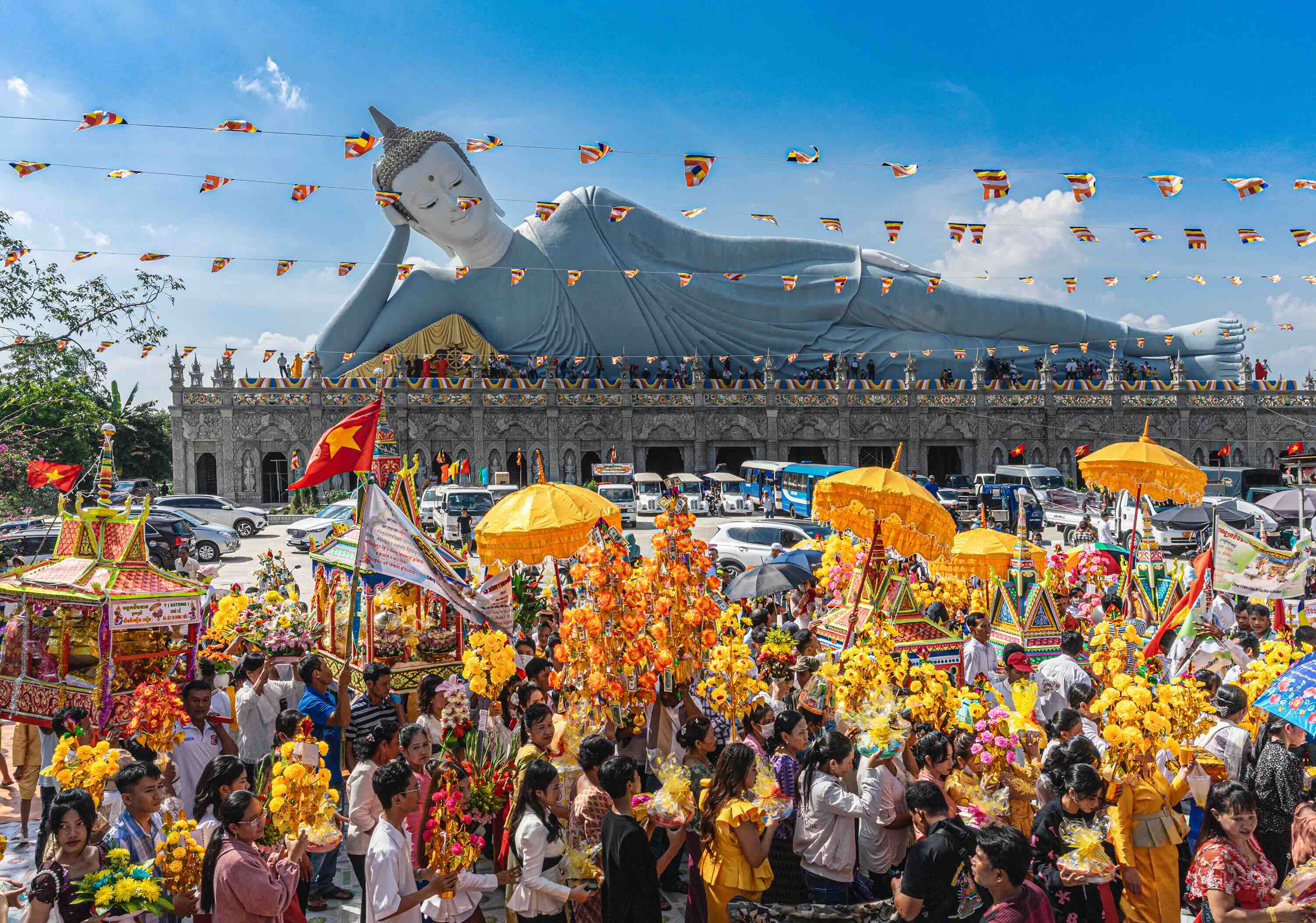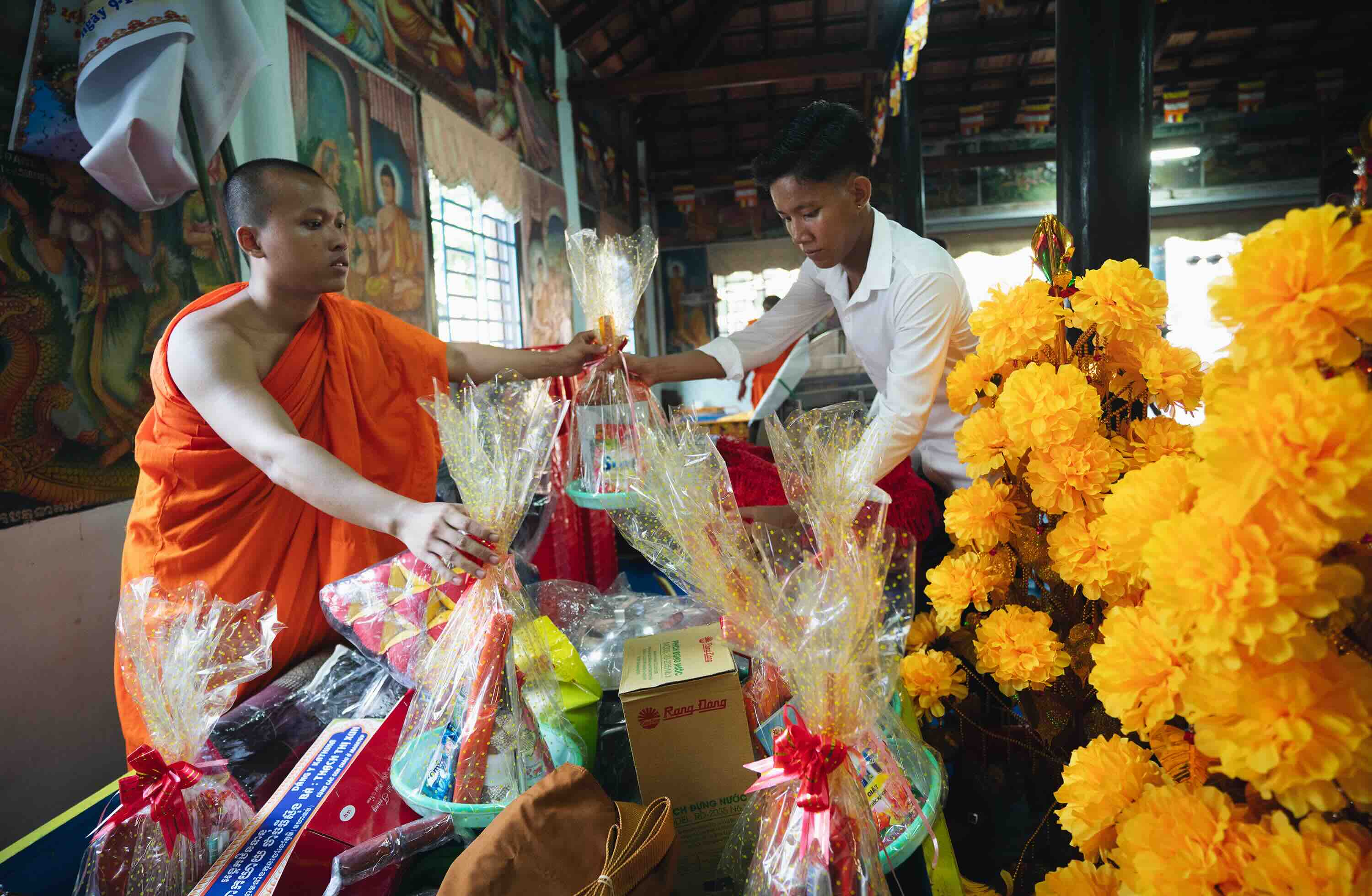Huynh Phuong
Three ethnic groups – the Kinh, Hoa, and Khmer – live harmoniously in Soc Trang province (now belongs to Can Tho City), located at the lower reaches of the Hau River. Accounting for over 31% of the local population, Khmer people continue to preserve their rich cultural identity through ancient customs and traditions, including the Kathina Robe-Offering Festival, also known as “the Offering of the Saffron Robe”.

Soc Trang (a part of Can Tho City) is home to more than 90 Khmer Theravada Buddhist pagodas. For the Khmer people, the pagoda serves not only as a place of worship but also as a hub for cultural and spiritual community life. Each year, from the 15th day of the 9th lunar month to the 15th day of the 10th, Khmer communities enthusiastically organize the Kathina Robe-Offering Ceremony at their local pagodas. Pagoda abbots hold meetings to select the ceremony date and notify local authorities and Buddhist households. Depending on the locality and residents’ economic conditions, the Kathina Festival may be celebrated on either a modest or a grand scale.
At its core, the robe-offering ritual expresses the pious goodwill of lay families who wish to make merit by donating items to Khmer templ. Beyond expressing religious devotion, it is also an occasion to wish for peace and prosperity within each hamlet and household, and to strengthen communal bonds.

The ceremony usually spans two days. On the first day, people pray at home, with monks reciting scriptures to bless the host family. Then, lay followers organize collections of donations, including silver flower trees – trees adorned with money, also known as money trees or silver/gold-leaf trees. The donations are used to purchase offerings for the pagoda. Along with saffron robes, considered the most sacred and essential item, donated items include alms bowls, and daily necessities such as wardrobes, beds, notebooks, pens, medicine, and food. The donated items symbolize gratitude and support for the monks and nuns who have renounced worldly life.
On the second day of the ceremony, the robe-offering procession circles the main hall three times upon arriving at the pagoda, a gesture of reverence before the Kathina robes are presented to the monks. Inside, the most senior elders of each clan are honored with the role of welcoming Buddhist followers and visitors on behalf of the pagoda. Devotees prepare their offerings with great sincerity, often carrying them on their heads as a sign of deep respect for the Three Jewels: the Buddha, the Dharma, and the Sangha. The key ritual – the offering of the robes – is held in the main hall in a solemn atmosphere, accompanied by other practices such as taking refuge in the Three Jewels, Dharma talks, peace chants, blessings, and the dedication of merit.

During the Robe-Offering Festival, some families also organize cultural performances such as Sa dam drum dances, Chhan dances, and horse-monkey dances. A highlight is the Chhan dance, performed by young men wearing hats, masks, and traditional costumes. Their presence at the pagoda symbolizes the transformation from wrong to right, while reminding devotees to perform virtuous deeds.
Outside the main gate, one cannot miss the charming sight of Khmer girls dressed in traditional attire, gracefully lining the pathway to welcome groups as they come to offer robes. Lucky visitors may come across a Kathina Robe-Offering Ceremony at a rural Khmer pagoda, where entire families line the roads in long, orderly rows to present their offerings, creating a solemn yet vibrant atmosphere.
The Kathina Robe-Offering Ceremony takes place three months after the monks’ Vassa retreat – a period of spiritual focus and study lasting from the 15th day of the 4th lunar month to the 15th day of the 7th month. It is typically held just before the Ngo Boat Racing Festival. Reflecting the profound human values of giving and receiving, this long-standing tradition stands as a vivid testament to the spiritual richness of Khmer communities in Southern Vietnam.
When visiting Soc Trang city (now a part of Can Tho City), travelers can experience the Kathina Robe-Offering Ceremony at renowned pagodas such as Mahatup (Bat Pagoda), Kh’leang, Somrong, Chroi Tum Chas (Old Tra Tim), Pothisatharam (Soc Vo), and Peam Buol Thmay (Sung Dinh). For those venturing further into the districts, Cham Pa Pagoda in Phu Huu commune is known for hosting a large-scale Kathina celebration. You may also wish to explore the oldest Khmer pagoda in Southern Vietnam, Trasathkong (Tac Gong Pagoda), which boasts a history of over 710 years and is located in Ngoc To commune.










